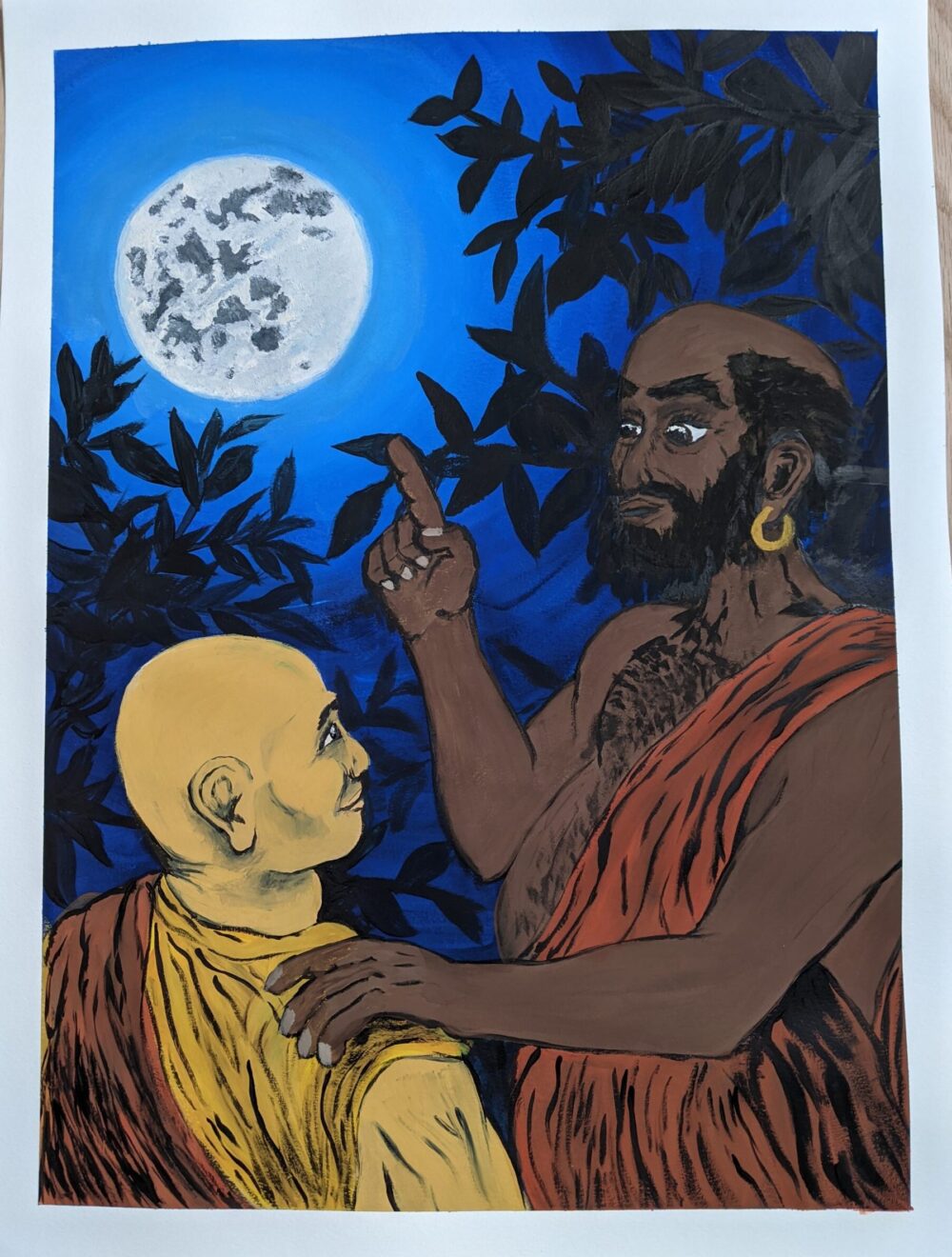This painting is the 8th in a series I did of Ukiyo E inspired paintings. It is painted in gouache and is 18×24 on 140 lb wc paper.
The painting depicts Bodhidharma giving the lesson of Mu to a Chinese Buddhist student.
“When Bodhidharma came to China, he saw that most Chinese learners did not grasp the truth of Buddhism. They merely sought it through interpretation of texts and thought of the changing phenomena all around them as real action. Bodhidharma wished to make these eager learners see that the finger pointing at the moon is not the moon itself. The real truth is nothing but one’s own mind.“
– Kuei-feng Tsung-mi (780-841)
Bodhidharma was a Buddhist monk who lived during the 5th or 6th century CE, traditionally credited as the transmitter of Zen Buddhism to China. He is revered as the first patriarch of Zen (Chan) Buddhism in China and is often depicted as a figure of great wisdom and enlightenment. One of the most famous teachings associated with Bodhidharma is the concept of “mu.”
1. Bodhidharma’s Background:
- Bodhidharma was born in Kanchipuram, India, and is said to have been a member of the Brahmin caste.
- He traveled to China during the 5th or 6th century CE, arriving at the Shaolin Monastery in Henan Province.
2. Teaching Zen Buddhism:
- Bodhidharma’s primary contribution to Chinese Buddhism was the transmission of Zen teachings, which emphasized direct insight into one’s true nature through meditation and intuition rather than through scripture or doctrine.
- He is credited with introducing the Lankavatara Sutra to China, a text that became influential in Zen Buddhism.
3. The Lesson of Mu:
- The concept of “mu” is often associated with Bodhidharma’s teaching style. The term “mu” comes from the Chinese word “wu” (無) or Japanese word “mu” (無), meaning “no,” “nothing,” or “without.”
- Bodhidharma is said to have used the word “mu” as a response to questions posed by his students, particularly in the context of koans (paradoxical riddles or statements used in Zen practice).
- The famous koan associated with Bodhidharma’s teaching of “mu” is: “What is the sound of one hand clapping?”
- “Mu” is often used to provoke a state of “no-mind” or to break through conceptual thinking, leading to a direct experience of reality beyond dualistic concepts.
4. Interpretations and Practice:
- The concept of “mu” is central to Zen practice, where it is used as a tool to cultivate mindfulness, awareness, and insight.
- Practitioners may meditate on the question “mu” or engage with other koans that incorporate the concept of emptiness or non-duality.
- Through sustained inquiry and meditation, practitioners aim to transcend the limitations of language and conceptual thinking, leading to a direct experience of reality or enlightenment.
5. Legacy and Influence:
- Bodhidharma’s teachings, including the lesson of “mu,” continue to be studied and practiced within Zen Buddhism and other contemplative traditions influenced by Zen.
- The concept of “mu” has also inspired philosophical discussions outside of Buddhism, exploring themes of emptiness, non-duality, and the limitations of language and thought.
Bodhidharma’s teaching of “mu” encapsulates the essence of Zen Buddhism, emphasizing direct experience, intuitive insight, and the transcendence of dualistic thinking. It remains a profound and enigmatic aspect of Zen practice, inviting practitioners to explore the nature of reality and the workings of the mind through mindful inquiry and meditation.



